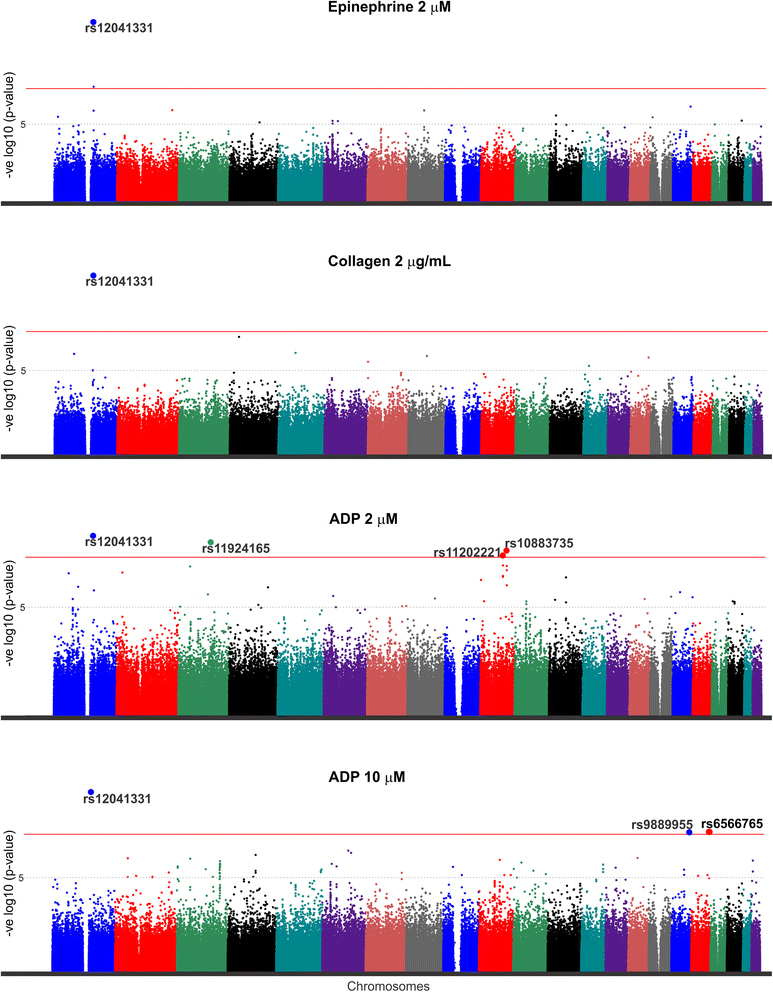Genome-wide association study of platelet aggregation in African Americans
- PMID: 26024889
- PMCID: PMC4448541
- DOI: 10.1186/s12863-015-0217-9
Genome-wide association study of platelet aggregation in African Americans
Abstract
Background: We have previously shown that platelet aggregation has higher heritability in African Americans than European Americans. However, a genome-wide association study (GWAS) of platelet aggregation in African Americans has not been reported. We measured platelet aggregation in response to arachidonic acid, ADP, collagen, or epinephrine by optical aggregometry. The discovery cohort was 825 African Americans from the GeneSTAR study. Two replication cohorts were used: 119 African Americans from the Platelet Genes and Physiology Study and 1221 European Americans from GeneSTAR. Genotyping was conducted with Illumina 1 M arrays. For each cohort, age- and sex-adjusted linear mixed models were used to test for association between each SNP and each phenotype under an additive model.
Results: Six SNPs were significantly associated with platelet aggregation (P<5×10(-8)) in the discovery sample. Of these, three SNPs in three different loci were confirmed: 1) rs12041331, in PEAR1 (platelet endothelial aggregation receptor 1), replicated in both African and European Americans for collagen- and epinephrine-induced aggregation, and in European Americans for ADP-induced aggregation; 2) rs11202221, in BMPR1A (bone morphogenetic protein receptor type1A), replicated in African Americans for ADP-induced aggregation; and 3) rs6566765 replicated in European Americans for ADP-induced aggregation. The rs11202221 and rs6566765 associations with agonist-induced platelet aggregation are novel.
Conclusions: In this first GWAS of agonist-induced platelet aggregation in African Americans, we discovered and replicated, novel associations of two variants with ADP-induced aggregation, and confirmed the association of a PEAR1 variant with multi-agonist-induced aggregation. Further study of these genes may provide novel insights into platelet biology.
Figures


Similar articles
-
Targeted deep resequencing identifies coding variants in the PEAR1 gene that play a role in platelet aggregation.PLoS One. 2013 May 21;8(5):e64179. doi: 10.1371/journal.pone.0064179. Print 2013. PLoS One. 2013. PMID: 23704978 Free PMC article.
-
Targeted deep sequencing of the PEAR1 locus for platelet aggregation in European and African American families.Platelets. 2019;30(3):380-386. doi: 10.1080/09537104.2018.1447659. Epub 2018 Mar 19. Platelets. 2019. PMID: 29553866 Free PMC article.
-
A meta-analysis and genome-wide association study of platelet count and mean platelet volume in african americans.PLoS Genet. 2012;8(3):e1002491. doi: 10.1371/journal.pgen.1002491. Epub 2012 Mar 8. PLoS Genet. 2012. PMID: 22423221 Free PMC article.
-
Genome-wide meta-analyses identifies seven loci associated with platelet aggregation in response to agonists.Nat Genet. 2010 Jul;42(7):608-13. doi: 10.1038/ng.604. Epub 2010 Jun 6. Nat Genet. 2010. PMID: 20526338 Free PMC article.
-
Genetic Association Studies in Uterine Fibroids: Risk Alleles Presage the Path to Personalized Therapies.Semin Reprod Med. 2016 Jul;34(4):235-41. doi: 10.1055/s-0036-1585401. Epub 2016 Aug 11. Semin Reprod Med. 2016. PMID: 27513025 Review.
Cited by
-
Transcriptional profile of platelets and iPSC-derived megakaryocytes from whole-genome and RNA sequencing.Blood. 2021 Feb 18;137(7):959-968. doi: 10.1182/blood.2020006115. Blood. 2021. PMID: 33094331 Free PMC article.
-
Metabolic trajectories across early adolescence: differences by sex, weight, pubertal status and race/ethnicity.Ann Hum Biol. 2019 May;46(3):205-214. doi: 10.1080/03014460.2019.1638967. Epub 2019 Jul 15. Ann Hum Biol. 2019. PMID: 31264447 Free PMC article.
-
Platelet and hemoglobin count at diagnosis are associated with survival in African American and Caucasian patients with colorectal cancer.Cancer Epidemiol. 2020 Aug;67:101746. doi: 10.1016/j.canep.2020.101746. Epub 2020 Jun 7. Cancer Epidemiol. 2020. PMID: 32521488 Free PMC article.
-
Factors that modulate platelet reactivity as measured by 5 assay platforms in 3429 individuals.Res Pract Thromb Haemost. 2024 Apr 12;8(3):102406. doi: 10.1016/j.rpth.2024.102406. eCollection 2024 Mar. Res Pract Thromb Haemost. 2024. PMID: 38813256 Free PMC article.
-
Ethnic Minorities and Coronary Heart Disease: an Update and Future Directions.Curr Atheroscler Rep. 2016 Feb;18(2):9. doi: 10.1007/s11883-016-0559-4. Curr Atheroscler Rep. 2016. PMID: 26792015 Free PMC article. Review.
References
-
- Nieswandt B, Pleines I, Bender M. Platelet adhesion and activation mechanisms in arterial thrombosis and ischaemic stroke. J Thromb Haemost. 2011;9(Suppl 1):92–104. - PubMed
-
- Lievens D, von Hundelshausen P. Platelets in atherosclerosis. Thromb Haemost. 2011;106(5):827–838. - PubMed
-
- Marcucci R, Gori AM, Paniccia R, Giusti B, Valente S, Giglioli C, et al. High on-treatment platelet reactivity by more than one agonist predicts 12-month follow-up cardiovascular death and non-fatal myocardial infarction in acute coronary syndrome patients receiving coronary stenting. Thromb Haemost. 2010;104(2):279–286. - PubMed
Publication types
MeSH terms
Substances
Grants and funding
LinkOut - more resources
Full Text Sources
Other Literature Sources
Molecular Biology Databases

